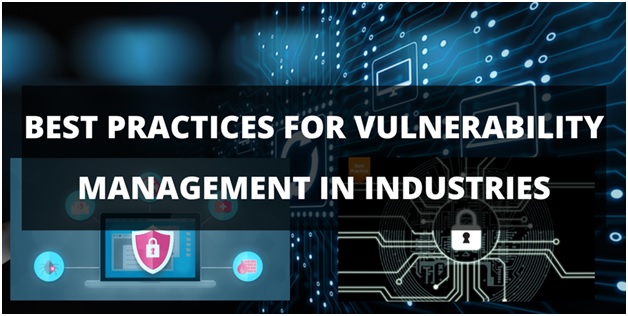Vulnerability Management is a key component of any information security plan, whether you are a CIO, IT manager, or engineer. A vulnerability management program can only perform to its full potential if it is built on a strong security foundation. The security foundation must have clearly defined goals and intended outcomes.


Vulnerability management is essential given the scope of cybercrimes, which are all on the rise. To prevent cyber security breaches, it is crucial to have a vulnerability management solution in place. This will ensure continuous scanning for emerging vulnerabilities and assist in their mitigation. An effective method for managing vulnerabilities and applying patches fixes outdated security holes.
What is Vulnerability Management?
A system’s vulnerabilities are security holes that might be used by hackers to obtain private information. They may disrupt services and harm other assets. Attackers always search for new weaknesses they may exploit and exploit.
Vulnerability management is the process of locating weaknesses, assessing risks, and mitigating them. Vulnerability management encompasses several processes, including vulnerability scanning and other factors. These include risk acceptance, mitigation, and remediation.
Operational technology (OT) vulnerability management is the practice of methodically addressing vulnerabilities that can be exploited in industrial control systems (ICS).
The following steps should be followed to carry out vulnerability management
- Identify assets
- Scan vulnerabilities
- Identify vulnerabilities
- Determine the severity of vulnerabilities
- Address vulnerabilities
Recommended Practices for Vulnerability Management in Industries
1. Establish a Vulnerability Management Strategy
A vulnerability management strategy enables you to improve visibility within your IT and OT infrastructure. This makes it possible for your company to quickly and efficiently respond to security issues.
Poorly designed vulnerability management strategies are less likely to provide meaningful outcomes. A company that wishes to develop an effective vulnerability management plan will put in place a thorough set of security measures that combines the following:
● Personnel: To successfully implement the plan, an organization’s security or IT and OT staff should be equipped with the essential knowledge and expertise. Their capacity to comprehend how security vulnerabilities impact the total OT ecosystem. Members of the team should also be able to interact successfully with other parties. These parties include the technical personnel, users, or business management.
● Process: The effectiveness of vulnerability management depends on the organization’s capacity to create a strong plan. The organization must also put in place processes that are doable and practical.
● Technology: Businesses should think about the best tools and configurations for their vulnerability management approach. These technologies ought to be able to do more than merely gather vulnerability data from the IT environment of the company. Additionally, they should incorporate ticketing systems, asset monitoring databases, and databases for assets.
2. Protect Attack Surfaces
An attack surface is the total number of all possible points or attack points where an illegal user can access a system and extract data.
Today’s applications are becoming more borderless, interconnected, sophisticated, and dynamic. This has increased the number of attack surfaces. So it is important to use anti-malware and endpoint protection tools to protect attack surfaces.
The hardware and physical equipment of a firm, as well as any staff devices that are permitted to connect to the corporate network, make up the physical attack surface of a corporation.
The physical attack surfaces in an organization are:
- Workstations
- Laptops
- Mobile device
- TVS
- Printers
- Routers
- Switches
- Surveillance cameras
Once a device has been compromised, an attacker may enter the corporate network and gain access to servers or other devices. From there, the hacker can access private data, compromise systems, or corrupt data.
3. Leverage Automation and Threat Intelligence
Based on the current state of the global threat environment. Threat intelligence assists in both prioritizing vulnerabilities and proactive patching to stop attacks. Global Threat Intelligence enables businesses to conduct deep and intelligent crawling and scanning. It also significantly lowers risks.
Automated vulnerability scanning tools comprise autonomous, high-level tests. It examines programs for potential flaws before producing thorough findings. These findings frequently include remedial advice.
4. Keep Vulnerability Management Database Up to Date
Simply creating the database once and leaving it alone is not adequate. Your whole security posture, including your vulnerability management database, is only as strong as the most recent data update. Therefore, you need to keep the vulnerability management database updated.
5. Perform Asset Discovery
Run a rapid discovery scan to create a comprehensive inventory of all the devices in your environment.
All types of Internet of things (IoT) devices should be examined, including production application servers, file servers, internal testing environments, and file servers. This is to make sure you look for any potential flaws that may provide access to the rest of your network.
Running scheduled discovery scans is also advised to make sure that every device on the network is covered. After your initial discovery scan, any new devices that join the network would not be subject to subsequent screening, which might lead to the environment becoming more vulnerable. Therefore, it is advised to scan gadgets often.
6. Identify and Remediate Vulnerabilities Speedily
Organizations must promptly identify security vulnerabilities and take action to fix them. However, there is a problem with vulnerability remediation: it may occasionally feel overwhelming. It could entail scan reports with a thousand pages or more, which might take time.
These three actions can be taken to fix vulnerabilities efficiently.
- Categorize: These vulnerabilities may be categorized to assist organizations to analyze problems. These categories could include things like obsolete software, configuration problems, and missing fixes.
- Prioritize: Not all vulnerabilities that have been found are created equal. A vulnerability scan gathers data on a significant scale and produces a thorough vulnerability report. Although not all of these threats are critical and require immediate attention. Firms should prioritize vulnerabilities and take appropriate action.
- Bite-size: To make your remediation process more manageable and efficient, divide it into small pieces. This should be done after you have classified and prioritized vulnerabilities.
7. Involve Your Whole Team
The biggest risk for most businesses is their people. So even if you were able to fix all of your organization’s vulnerabilities, it wouldn’t eliminate that risk. In reality.
Of course, the majority of employees do not intentionally aim to put your company in danger for security. Your staff’s blunders, carelessness, or lack of understanding of safe cyber procedures frequently result in vulnerabilities being introduced.
Weak passwords, connecting to public Wi-Fi hotspots, and falling for phishing scams are all security hazards. A breach might easily result from something as innocent as leaving the computer at your workplace unsecured while you take a break.
Therefore, employees must have a solid understanding of the fundamental cybersecurity principles. As well as your business’s efforts to address vulnerabilities. Typically, holding regular staff training sessions is the most effective approach to involve your team.
Conclusion
To defend your company against cyber-attacks, it is recommended to use these vulnerability management best practices.
Consider expanding your vulnerability management solution to include your whole network. These include servers, printers, phones, PCs, test servers, etc. if you currently use one.
Now is the moment to deploy a vulnerability management system if you don’t already have one. You may get in touch with us as well for further details and assistance protecting your company from online dangers.
















